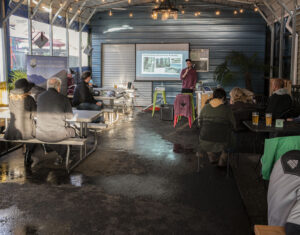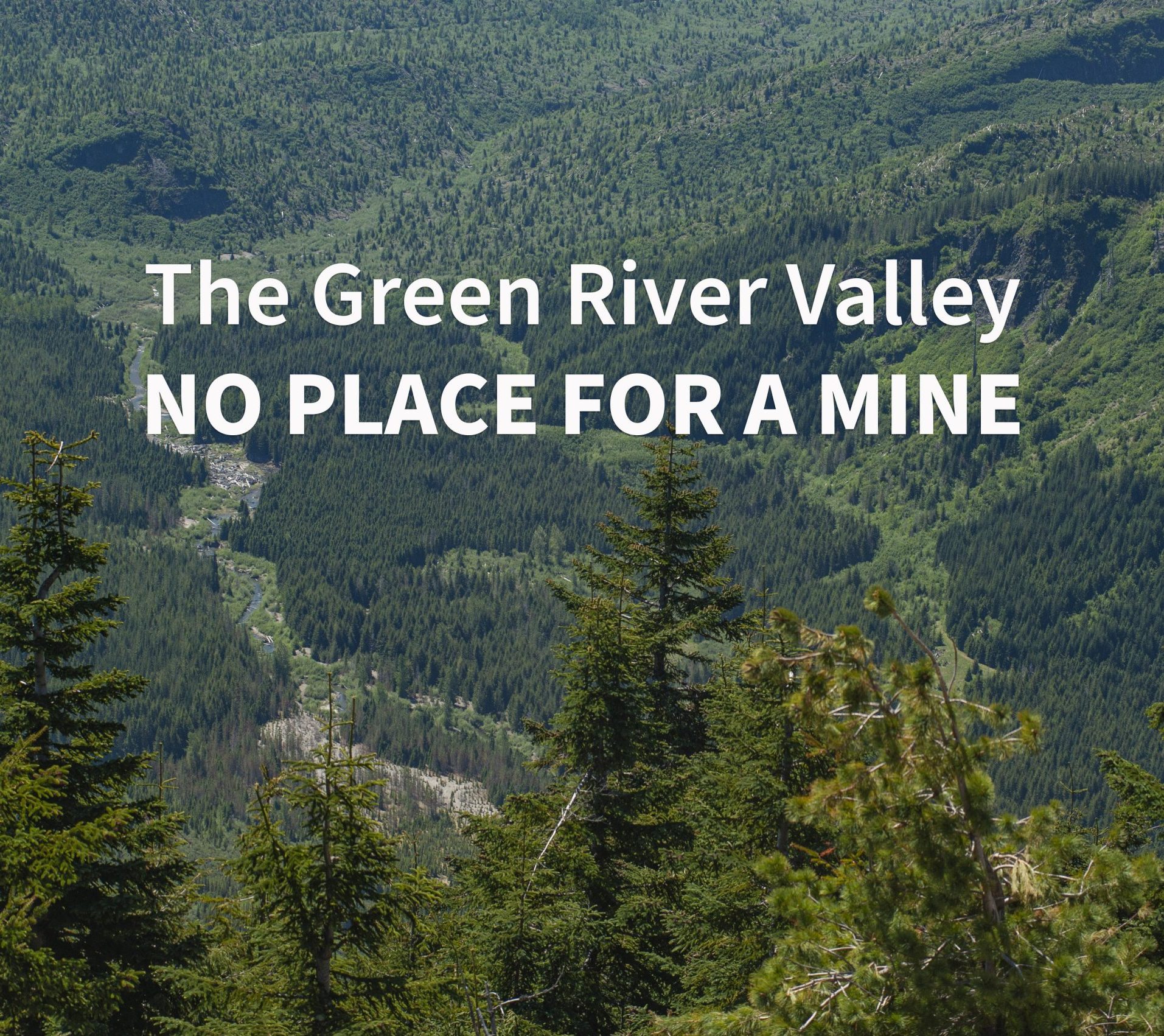Just over a year ago, on October 5, 2021, we came together with supporters at Trap Door Brewing in Vancouver, Washington for our first ‘No Place For A Mine’ event under our new revamped campaign. That evening we formally announced the creation of the Green River Valley Alliance – a coalition of individuals, businesses, organizations, and policymakers organized to achieve the common goal of protecting the Green River Valley and Mount St. Helens from the threat of mining. In the year since, the Alliance has continued to grow so we wanted to take a moment to provide an update and acknowledge our progress!

That first gathering at Trap Door kicked off a series of monthly events in which we presented our campaign, held engaging Q&A sessions, and met hundreds of people who took action to support the campaign! To date, we’ve hosted 11 of these ‘Pint Night’ events at breweries across the region from Portland to Seattle and from Yakima to Packwood. In addition to these larger events, the Alliance has also held a number of smaller tabling sessions at a variety of venues which have offered further opportunities to expand and connect with our growing community of supporters.
The Alliance began working to collect signatures on our petition and business/organization sign-on letter asking Congress to enact a mineral withdrawal. We also produced postcards featuring a watercolor of Mount St. Helens and the Green River Valley by local artist Lindsey Fox, for a letter writing campaign aimed at winning over our federal elected officials. As of today, we have sent hundreds of postcards to federal officials and the Alliance has the endorsement of over 1500 individuals, 33 supporting businesses, and 21 Alliance Partner organizations!

In addition to our public outreach, we’ve also been forging relationships with local and regional stakeholders. We’ve met with several local elected officials and are engaging the local forest collaboratives. We have also been working in partnerships with both the Cowlitz Indian Tribe and the Confederated Bands and Tribes of the Yakama Nation, who are key allies in this work and who strongly oppose mining in this area. Finally, we’ve been strengthening our relationships with our federal elected officials, who we will ultimately need to champion legislation through Congress.
February 2022 was a particularly exciting time for the campaign as we had two exciting announcements to share at our event that month. First, we announced the launch of www.greenrivervalleyalliance.org — a resource for learning about why the Green River Valley and Mount St. Helens are no place for a mine and our mineral withdrawal campaign, receive updates, hear about upcoming events, and take action.
We also were able to share the incredible news that we had won our most recent legal case to stop this mine from moving forward. A US District Court judge ruled that the US Forest Service and Bureau of Land Management had failed to identify the existing condition of groundwater in the area, did not adequately account for all of the negative impacts on access to the Green River Valley area for recreational purposes, and did not define the length of time over which exploratory drilling would take place. Because of these deficiencies the exploratory drilling permits, originally granted by the agencies in 2018, were canceled–or in legal terminology, vacated. This meant that drilling would not take place in the summer of 2022 and that Ascot Resources, the Canadian mining company that currently holds the mineral rights to the area, would need to start the permitting process over again.

With this legal win behind us, we continued to push forward. This victory may have bought some much-needed time, but it did not provide permanent protections against mining. We know from experience that it is likely that Ascot will seek exploratory drilling permits again.
This summer, we began hosting regular Green River Valley Alliance coalition calls, in which members from our partner organizations came together to share information and strategize about ways to engage the public and move the campaign forward. Alliance partners have assisted in campaign strategizing, written newsletter articles, helped spread our petition, engaged their networks, collected postcards, and shared about our efforts on social media. This collaborative aspect of the Alliance is a key component of our work and these coalition calls are now a cornerstone of this campaign and will remain so moving forward.
In support of our continued work as an Alliance, here are a couple of actions you can take right now to help us maintain the momentum we have built up over the past year. If you have already taken these actions, then please send this to three or more friends, family members, colleagues, neighbors, or anyone else you think may be interested in helping us protect this incredible landscape.
- Please take a moment to sign our petition! Help convince policy makers to take action! Let’s crank up those signature numbers and spread the word about this important issue!
- Sign on as an Alliance Partner with your business or organization! If you are a business owner or a member of an organization that you believe would be supportive of our work, use this sign-on letter to demonstrate your group’s support for this campaign. To convince elected officials to act, we need backing from the business community!
The Green River Valley Alliance accomplished a great deal in its first year. We’ve pulled together large numbers of concerned citizens, businesses, and organizations representing a variety of viewpoints, backgrounds, and interests around the shared goal of securing a legislative mineral withdrawal to ensure permanent protections for the Green River Valley and Mount St. Helens against the threat of mining. While we are proud of our progress so far, and grateful for all the support we’ve received up to this point, we still have a long way to go. I am optimistic we can make our goal a reality, and I am looking forward to continuing working with all of you to make this a priority issue for our elected officials!
We want to give a special thank you to our incredible Alliance Partners and Supporting Businesses! Thank you for your continued support as we continue to push forward!
ALLIANCE PARTNERS
American Whitewater; Backcountry Hunters & Anglers – Washington Chapter; Cascade Forest Conservancy; Clark-Skamania Fly Fishers; Columbia Riverkeeper; Conservation Northwest; Evergreen Mountain Bike Alliance; Friends of Clark County; Great Old Broads; Mazamas; The Mountaineers; Patagonia; Trans-Cascadia; The Wilderness Society; Vancouver Audubon Society; Vancouver Wildlife League; WA Native Plant Society; Washington Council of Trout Unlimited; Washington Trails Association; Washington Wild; Wild Steelheaders United
SUPPORTING BUSINESSES
Adorn Body Art; Base Camp Coffee; The Bicycle Doctor; Camas Bike & Sport; Carson Ridge Luxury Cabins; Compass Coffee Roasting; Coyote Ridge Ranch; C. Rose’s Ink; Definitely Mabie Consulting LLC; Domaine Pouillon; Full Plate Farm; French’s Farm; Harold’s Burger Bar; Kindred Homestead Supply; Oakshire Beer Hall; Optimism Brewing; Loowit Brewing Company; Lucky No. 3 Tattoo Company; Maple Tree Goatscaping LLC; Medical Vision Center; Monet Vineyards; Mountain Goat Tattoo Co.; North Bank Books; Octopi Ink; Packwood Station; Pariyatti; Raintree Nursery; River House Bake Shop; Roberta Church, Attorney at Law; Shanahans Pub & Grill; Soul Crafted Soap; Thatcher’s Coffee; TNS Archery Outdoors; Trap Door Brewing; Wickering Heights















